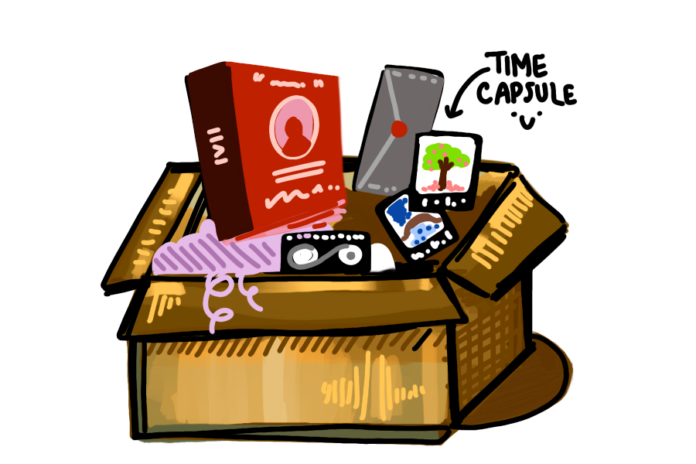Years into the future, you may discover forgotten memories of who you were
By MAYA KORNYEYEVA — mkornyeyeva@ucdavis.edu
Humans crave discovery. From sailing the seas to sending rockets into space to uncovering ancient civilizations, we are fueled by a desire to seek out new things and learn more about the universe. We also love self-discovery, whether it’s in the form of trying out novel hobbies or writing down our memories to elucidate trends in our behavior or changes in our worldviews.
Alongside discovering the new, we bask in the instant gratification of being the first to try out and witness something. To speak for myself, I love opening presents from friends and family, tearing open that Amazon package I’ve been waiting months for or taking my first steps in a travel destination.
Historically, people have combined these two great affections in the preservation of time capsules — of themselves or their collective generation — for future discovery. Time capsules often contain objects or mementos that are attributed to a certain period of time, such as photographs, posters, books, cassette tapes and small everyday objects that hold symbolic importance. These simple items could range from a stuffed animal to a pin to an article of clothing: anything works if there’s a strong memory or personal connection attached to it.
In the creation of a time capsule, one is essentially suspending a single moment in time as they lived and experienced it and stowing it away for years or even decades to be rediscovered. Once the box is opened and its contents are revealed, it’s as if a person is “reliving” that period of their (or someone else’s) life, gaining back often forgotten memories as they sift through the carefully selected objects in the time capsule. In this way, putting together a personal box for your future self is a crucial activity that not only preserves important memories but also serves as an action of self-reflection.
For many college students like myself, life moves at an incredibly fast pace. We are constantly rushing from one class to the next, hopping from an internship to a job, moving to new cities and traveling across the world. As our perception of time continues to speed up, years will fly by and memories of our early lives will fade into the background. Even my own memories of my childhood have grown dimmer, and it takes some serious, conscious effort and lots of photographs to bring vivid memories back to the surface.
A few months back, I discovered a time capsule that I created for myself in the third grade. It was an experience similar to opening a treasure box. Inside, I found pictures of my friends and me during elementary school, my small marble collection and cloth swatches from my favorite t-shirt. There were also tiny drawings that I had done in class, along with a letter I wrote to myself so many years ago.
Discovering this box of memories was an emotional whirlwind. I remembered much more beyond the contents of the box. I remembered powerful memories that — thanks to my third-grade self — I was given a chance to re-experience. The time capsule served its effective purpose, bringing me joy and gratification as I reflected on who I was and how much I had grown.
I highly recommend that you create your own time capsule. Choose a few objects or photos of memorable moments, something you want to remind yourself of a few years down the line. Add a recording of your favorite song (or maybe a list of favorites), and write down a note about what’s going on with your current self. Who do you want to be? What are your goals, and what do you love to do? What do you want your future self to remember? Writing down the answers to these questions will help you critically evaluate your own position, to generate a plan for the future and ground yourself in the present moment.
The truth is, we all want to be remembered. Maybe we want to remember our own experiences in the future, maybe we want others to recognize our achievements or perhaps simply to acknowledge our existence. Memory, along with shared memories, is an intrinsic part of being human. Through memories, we learn and adapt, change and transform ourselves into who we want to be. All you need is a box, a few notable items and some time.
Written by: Maya Kornyeyeva — mkornyeyeva@ucdavis.edu
Disclaimer: The views and opinions expressed by individual columnists belong to the columnists alone and do not necessarily indicate the views and opinions held by The California Aggie.







